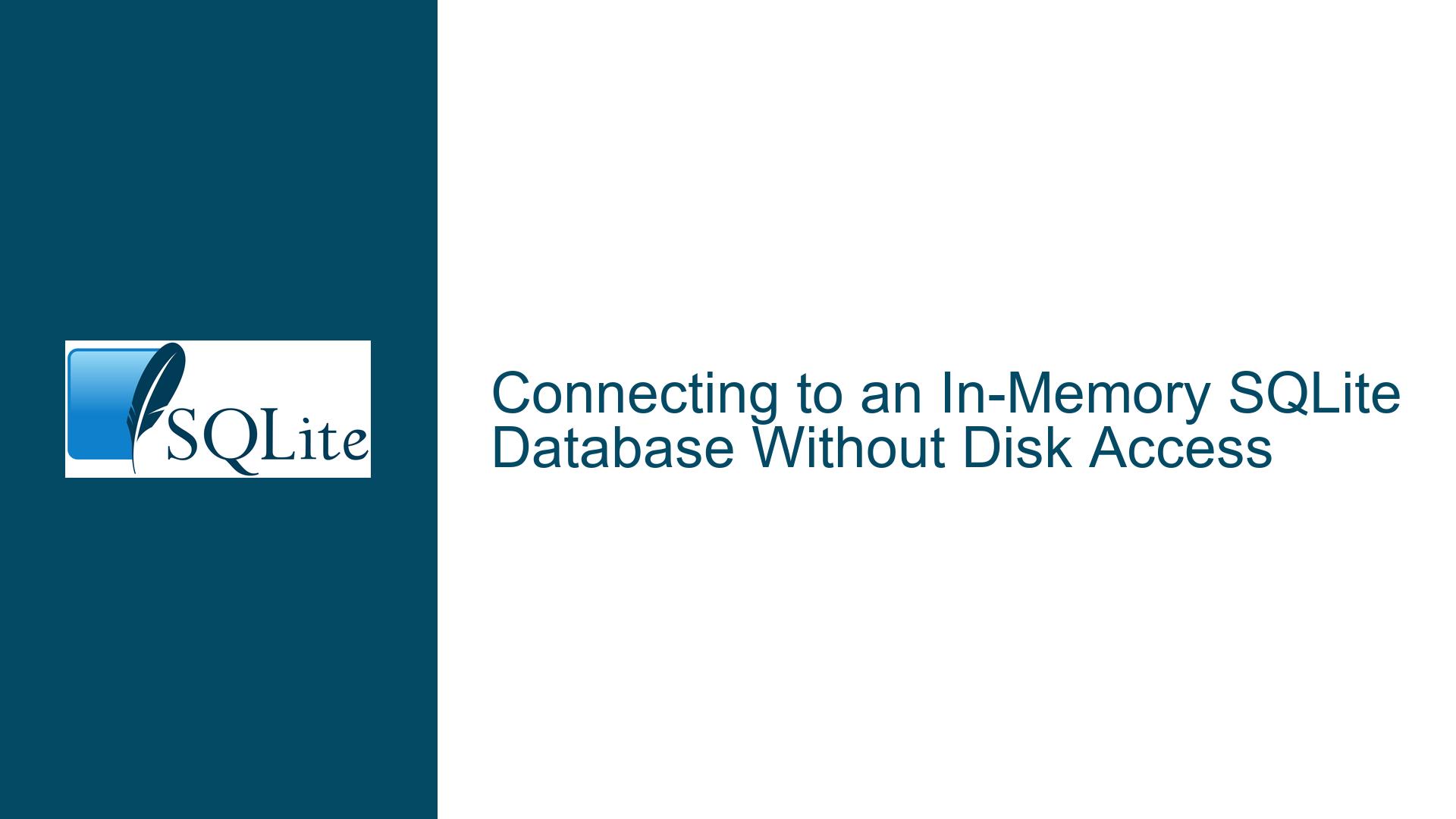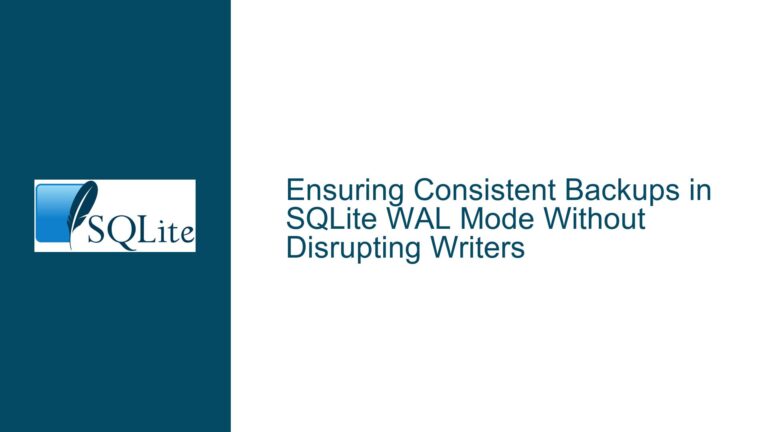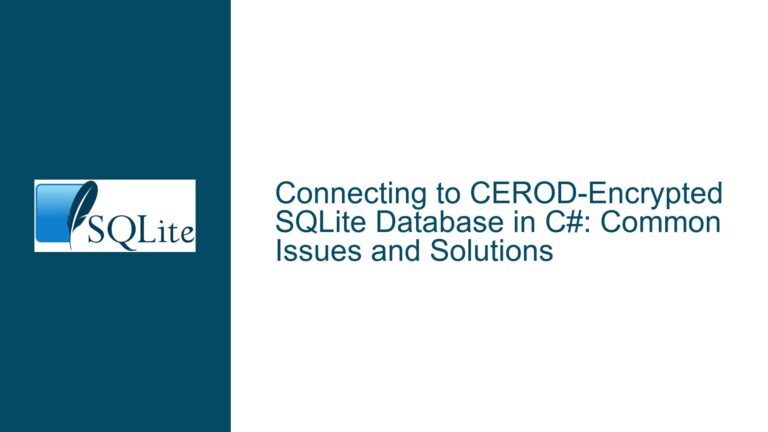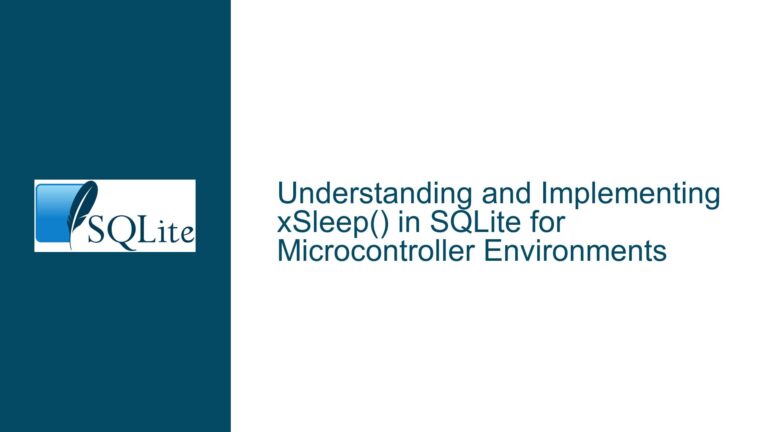Connecting to an In-Memory SQLite Database Without Disk Access
Understanding the Core Problem: SQLite Database in Memory Without Disk Access
The core issue revolves around connecting to an SQLite database that resides entirely in memory, without any access to disk storage. This scenario is particularly challenging because SQLite traditionally relies on file-based storage for its databases. When a database is stored in memory, it is typically ephemeral, meaning it exists only for the duration of the connection and is lost once the connection is closed. However, the user in this scenario has a database file already loaded into memory, but lacks the ability to use disk-based operations to interact with it. This raises several questions about how to establish a connection to this in-memory database and perform operations on it without relying on traditional file I/O.
The user’s environment is diskless, which means that conventional methods of connecting to an SQLite database, such as specifying a file path, are not feasible. The user is also unable to use disk-based operations to restore or backup the database, which further complicates the situation. The challenge, therefore, is to find a way to connect to and interact with an SQLite database that exists solely in memory, without any reliance on disk storage.
Possible Causes: Why Traditional Methods Fail in a Diskless Environment
The primary reason traditional methods fail in this scenario is that SQLite is designed with the assumption that databases are stored on disk. The SQLite library provides several mechanisms for interacting with databases, most of which are file-based. For example, the standard connection string for an SQLite database includes a file path, such as jdbc:sqlite:C:/sqlite/db/sample.db. This connection string tells SQLite where to find the database file on disk. However, in a diskless environment, this approach is not viable because there is no disk to store or retrieve the database file.
Another issue is that SQLite’s in-memory database feature, accessed via the connection string jdbc:sqlite::memory:, creates a new, empty database in memory. This is not suitable for the user’s needs because they already have a database file loaded into memory and need to connect to that specific database, not a new one. The in-memory database created by jdbc:sqlite::memory: is ephemeral and cannot be used to access an existing in-memory database.
Furthermore, the user’s environment lacks the file operations typically provided by an operating system, such as fopen(), fread(), fwrite(), and fclose(). These operations are essential for SQLite’s default file access mechanisms, which rely on the underlying operating system’s file I/O capabilities. Without these operations, SQLite cannot interact with files in the usual way, making it impossible to use traditional file-based methods to access the database.
Troubleshooting Steps, Solutions & Fixes: Connecting to an In-Memory SQLite Database Without Disk Access
To address the issue of connecting to an in-memory SQLite database without disk access, several approaches can be considered. Each approach has its own set of challenges and trade-offs, and the best solution will depend on the specific requirements and constraints of the user’s environment.
1. Using a Custom Virtual File System (VFS)
One potential solution is to implement a custom Virtual File System (VFS) for SQLite. A VFS is an abstraction layer that SQLite uses to interact with the underlying storage system. By default, SQLite uses a VFS that relies on the operating system’s file I/O functions. However, it is possible to create a custom VFS that interacts with memory instead of disk.
A custom VFS would need to provide implementations for the necessary file operations, such as opening, reading, writing, and closing files. In this case, the "files" would actually be in-memory data structures. The custom VFS would need to manage these data structures in a way that mimics the behavior of a traditional file system, allowing SQLite to interact with the in-memory database as if it were a file on disk.
Implementing a custom VFS is a complex task that requires a deep understanding of SQLite’s internals and the specific requirements of the user’s environment. However, it is a powerful solution that can provide the flexibility needed to work with in-memory databases in a diskless environment.
2. Leveraging SQLite’s Shared Cache Mode
Another approach is to use SQLite’s shared cache mode, which allows multiple connections to share the same in-memory database. This mode is typically used in multi-threaded applications where multiple threads need to access the same database. However, it can also be used in a diskless environment to share an in-memory database between different processes or components of the system.
In shared cache mode, the in-memory database is managed by a single SQLite instance, and other connections can attach to this instance to access the database. This approach requires that the initial connection to the in-memory database be established in a way that allows other connections to attach to it. Once the initial connection is established, other connections can use a special connection string to attach to the shared in-memory database.
This approach has the advantage of being relatively simple to implement, as it leverages existing SQLite features. However, it may not be suitable for all environments, particularly those where the initial connection cannot be established in a way that allows other connections to attach to the shared in-memory database.
3. Using SQLite’s Backup API to Transfer Data to an In-Memory Database
If the user’s environment allows for some form of data transfer, it may be possible to use SQLite’s Backup API to transfer the contents of the in-memory database to a new in-memory database. The Backup API allows for the efficient copying of data between two SQLite databases, even if one of them is in memory.
In this approach, the user would first establish a connection to the existing in-memory database using a custom VFS or other mechanism. Then, they would create a new in-memory database using the standard jdbc:sqlite::memory: connection string. Finally, they would use the Backup API to copy the data from the existing in-memory database to the new one.
This approach has the advantage of being relatively straightforward to implement, as it uses existing SQLite features. However, it requires that the user’s environment support some form of data transfer, which may not be possible in all cases.
4. Implementing a Custom Data Access Layer
If none of the above solutions are feasible, the user may need to implement a custom data access layer that interacts directly with the in-memory database. This approach would involve bypassing SQLite’s standard file-based mechanisms and instead using custom code to read and write data directly to the in-memory database.
Implementing a custom data access layer is a complex task that requires a deep understanding of the database’s structure and the specific requirements of the user’s environment. However, it provides the ultimate flexibility, allowing the user to interact with the in-memory database in any way they see fit.
This approach would likely involve creating custom functions for opening, reading, writing, and closing the in-memory database, as well as managing transactions and other database operations. The custom data access layer would need to be tightly integrated with the rest of the application, ensuring that all database interactions are handled correctly.
5. Exploring Alternative Lightweight Databases
If the user’s environment is too constrained to support any of the above solutions, it may be worth considering alternative lightweight databases that are better suited to in-memory operation. For example, some databases are designed specifically for in-memory use and do not rely on file-based storage at all.
One such database is Redis, which is an in-memory data structure store that can be used as a database, cache, and message broker. Redis is designed for high-performance, in-memory operation and does not rely on disk storage for its primary data store. However, it is important to note that Redis is not a direct replacement for SQLite, as it uses a different data model and does not support SQL queries.
Another option is SQLite’s own in-memory database feature, accessed via the jdbc:sqlite::memory: connection string. While this feature creates a new, empty database in memory, it may be possible to use it in conjunction with other techniques to achieve the desired result. For example, the user could use a custom VFS or data transfer mechanism to populate the in-memory database with data from the existing in-memory database.
Conclusion
Connecting to an in-memory SQLite database without disk access is a challenging problem that requires a deep understanding of SQLite’s internals and the specific constraints of the user’s environment. Several potential solutions exist, including implementing a custom VFS, leveraging SQLite’s shared cache mode, using the Backup API to transfer data, implementing a custom data access layer, and exploring alternative lightweight databases.
Each of these solutions has its own set of challenges and trade-offs, and the best approach will depend on the specific requirements and constraints of the user’s environment. By carefully considering these options and selecting the most appropriate solution, it is possible to successfully connect to and interact with an in-memory SQLite database in a diskless environment.





